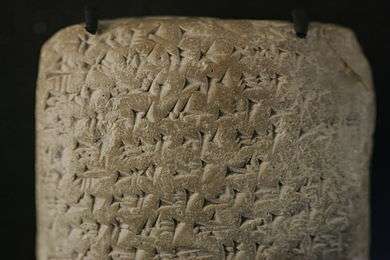Nu (cuneiform)

| Wikimedia Commons has media related to Nu (cuneiform). |
| Wikimedia Commons has media related to Cuneiform signs, Amarna letters. |
Cuneiform sign nu is a common use syllabic, or alphabetic (for n or u). It is restricted to "nu", but in the Epic of Gilgamesh, or elsewhere has a sumerogram (capital letter, majuscule) use NU, and probably mostly for a component in personal names (PN), god's names, or specialized names for specific items that use sumerograms.
It is also a common use syllabic/alphabetic sign in the mid 14th-century BC Amarna letters. Since the letters often discuss 'present conditions' in regions, or in cities of the vassal Canaanite region, a segue adverb meaning "now", or now, at this time..., Akkadian language "enūma"[3] is often used, and almost exclusively using nu.
The usage numbers for nu in the Epic of Gilgamesh are as follows: nu-(317), NU-(2).[4]
Two styles of "nu" sign
Since the nu cuneiform sign is in a small category of "2-stroke" signs, it is interesting that there exist two simple varieties of the sign. After the first horizontal stroke is made, it is seen that in many uses an upward stroke is laid upon it (as in the digitized version shown). The second variety is a complete wedge-style stroke placed upon the horizontal. The premier example shown is on the photo of the reverse of Amarna letter EA 365 (top photo), in the 2nd line, (line 365:16, reverse).
Also, line art drawings of cuneiform signs, from a document, or article have the possibility of showing the nu sign with either of the two types of the sign, showing either, (arrow) wedge strokes, or a wedge stroke (full triangle-type) stroke. The alternate wedge-triangle type would look similar to this: ![]() , but the wedge moved to the center, or beginning of the horizontal (adjacent the head of the horizontal stroke).
, but the wedge moved to the center, or beginning of the horizontal (adjacent the head of the horizontal stroke).
Akkadian language "nukurtu"
In the Amarna letters, the spelling of Akkadian language (nuKÚRtu), "nukurtu",[5] for war, or hostilities, is almost exclusively spelled starting with nu, but ending with various syllabics to supply the "t" ending.
See also
- KÚR (cuneiform)#List usage in Amarna letters, for nu of Akkadian "nukurtu"
References
- ↑ Moran, William L. 1987, 1992, The Amarna Letters, letter EA 365, Furnishing Corvée Workers, p. 363
- ↑ Rainey, 1970. El Amarna Tablets, 359-379, Glossary:Vocabulary, hazzanu, pp. 55-87, p. 64.
- ↑ Parpola, 197l. The Standard Babylonian Epic of Gilgamesh, Glossary, pp. 119-145, enūma, p. 122.
- ↑ Parpola, 197l. The Standard Babylonian Epic of Gilgamesh, Sign List, pp. 155-165, no. 075, p. 156.
- ↑ Parpola, 197l. The Standard Babylonian Epic of Gilgamesh, Glossary, pp. 119-145, nukurtu, p. 135.
- Moran, William L. 1987, 1992. The Amarna Letters. Johns Hopkins University Press, 1987, 1992. 393 pages.(softcover, ISBN 0-8018-6715-0)
- Parpola, 197l. The Standard Babylonian Epic of Gilgamesh, Parpola, Simo, Neo-Assyrian Text Corpus Project, c 1997, Tablet I thru Tablet XII, Index of Names, Sign List, and Glossary-(pp. 119–145), 165 pages.
- Rainey, 1970. El Amarna Tablets, 359-379, Anson F. Rainey, (AOAT 8, Alter Orient Altes Testament 8, Kevelaer and Neukirchen -Vluyen), 1970, 107 pages.
|
|


